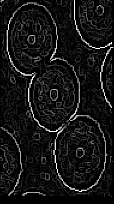Package com.openinventor.imageviz.engines.edgedetection.edgemarking
With gradient (ex: SoGradientOperatorProcessing2d) or laplacian (ex: SoRecursiveLaplacianProcessing) engines, a 1D edge was defined as the local maximum of the magnitude of the first derivative, or the zero crossing of the second derivative. Unfortunately, this definition cannot be extended to 2D functions (like for instance SoGradientLocalMaximaProcessing2d). In fact, an edge appears like a crest line on the magnitude of the gradient image and this leads us to define an edge as all the points whose gradient magnitude is maximum along the direction of the gradient, i.e the direction across the edge. This method, referred to as non-maxima suppression, provides thin lines which are much more convenient to handle.
Note that images of zero crossings of the Laplacian result in closed thin lines as they correspond to boundaries between positive and negative regions. Finally, we can take into account the specific geometry of a contour - its pixels are connected by using a more sophisticated threshold, the threshold by hysteresis (SoHysteresisThresholdingProcessing).
This is in fact an intuitive method. We choose a high and low threshold,  and
and  , and decide that all the pixels with intensity higher than
, and decide that all the pixels with intensity higher than  are edges and those with are edges and those with intensity less than
are edges and those with are edges and those with intensity less than  are noise. For the transition area
are noise. For the transition area  , i.e. pixels with intensity lies between
, i.e. pixels with intensity lies between  and
and  , we only retain the pixels connected by a line included in
, we only retain the pixels connected by a line included in  to a pixel with a high intensity.
to a pixel with a high intensity.



-
Class Summary Class Description SoCannyEdgeProcessing SoCannyEdgeProcessing.SbCannyEdgeDetectionDetail Results details of canny edge detection workflow.SoDijkstraShortestPathProcessing2d SoEigenvaluesToStructurenessProcessing2d SoEigenvaluesToStructurenessProcessing2dengine computes a structure score image.SoEigenvaluesToStructurenessProcessing3d SoEigenvaluesToStructurenessProcessing3dengine computes a structure score image.SoGaussianGradientTensorProcessing2d SoGaussianGradientTensorProcessing2dengine computes the structure tensor.SoGaussianGradientTensorProcessing3d SoGaussianGradientTensorProcessing3dengine computes the structure tensor.SoGradientLocalMaximaProcessing2d SoGradientLocalMaximaProcessing3d SoRidgeDetectionProcessing SoRidgeDetectionProcessingengine.SoTensorVotingProcessing2d SoTensorVotingProcessing2dengine.SoZeroCrossingsProcessing2d SoZeroCrossingsProcessing2dengine.